Duel BMW nine T Pure Vs Honda CB1100 RS: classic pleasures
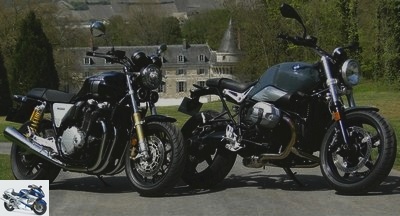
Beautiful, chic and very legitimate in the neo-retro motorcycle segment, the Honda CB1100 only won over 125 French bikers in 2016. The Japanese manufacturer spices up its recipe with an RS variant with more assertive flavors, openly inspired by the very tasted BMW R Nine T and its 1000 annual sales ! MNC duel between the new Nine T Pure and the 2017 CB1100 RS.
Duel R Nine T Pure Vs CB1100 RS page 2 – Dynamics: sport suggested on the Honda, assumed on the BMW
The rays of the spring sun are reflected almost painfully on the chrome of the silencers of the CB1100 RS, while the R Nine T Pure barks happily with a few bursts of gas, which causes that side sway characteristic of older generations of flat twins. Before even taking the handlebars, the Honda and the BMW make you want to be contemplated and listened to, with a smile on your face: both trigger emotions, a key factor on this type of motorcycle. !
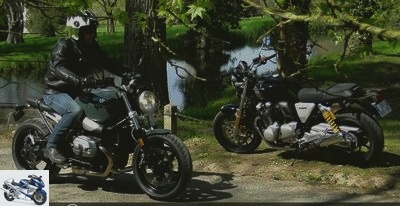
Rather low and of contained width, these two new retro motorcycles offer a relaxed position, with a significant advantage for the Honda in terms of absence of constraints on the legs in particular. The CB1100 surprises on the other hand with its rather narrow handlebars, lowered and advanced compared to its standard version "EX" and its spoked rims. Conversely, the handlebar of the BMW is very wide and forms a kind of practically flat semi-circle, as on very old motorcycles. Its leverage is significantly increased compared to that of the CB.
Yet higher in the saddle, the BMW (805 mm) is more accessible than the Honda (795 mm) thanks to its general narrowness, which it owes to its flat twin, less bulky than the "4-legged". This very specific architecture, specific to BMW motorcycles since, also gives it an extremely low center of gravity. Thanks to this feature and its wide handlebars, the handling of the Pure is incomparably superior to that of the CB1100RS. The sporty genes of the "all-short" Nine T are not far off !
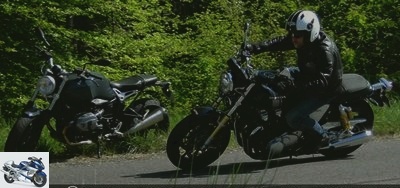
The German dives in curves without hesitating or slowing down when the Japanese take the time to soak a toe before entering the water! Less incisive, almost clumsy in comparison, the Honda behaves in accordance with its appearance: old-fashioned. Its high weight (252 kg against 219 kg for the Pure) explains this superior inertia, which suggests a coiled rather than sporty driving. If the pilot is insistent, his low ground clearance definitely calls him to order, while that of the BMW is almost unfathomable on the road..
In addition, the widening of the tires of the CB1100 RS compared to the (mounted in 110/80/18 and 140/70/18) tends to slightly tape it to the bitumen, despite its closed caster angle (26 ° on the RS against 27 on the EX). Its handlebars lower and narrower than on the EX does not help matters: the bike loses in liveliness and ease what it gains in look..
Honda operates springs – very – classic
Another brake to energetic driving on the CB 1100 RS: its perfectible suspension tuning, distinguished by a rather flexible double valve fork and super firm rear combinations. This hardness is noticeable from the installation in the saddle: the Japanese hardly sinks under our 70 kg, with a preload yet close to its minimum threshold (2nd notch). In this, the Honda really sends back in the past, towards not really regretted generations of motorcycles "slapstick"….
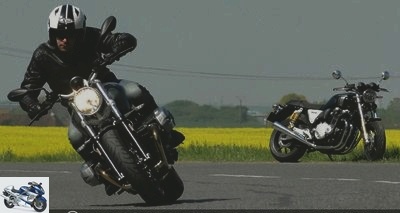
The R nineT Pure’s suspension tuning is more convincing, with enough flexibility to provide some comfort. An interesting compromise which softens the rigidity of its trellis frame. In the end, the German is much less "restless" in the bumpy parts while being more rigorous: full box! Too bad its narrow and hard saddle tarnishes the picture, when that of the Honda brings the hint of damping necessary to withstand the drought of its handsets.
The better braked fork of the BMW supports moreover more constraints, in particular during the phases of braking during which its "simple" axial calipers bite more effectively its discs of 320 mm. Despite its radial mounting, the CB1100 RS is not a formidable braking machine, for lack of power to summon firmly to the right lever. Conversely, its rear brake is exemplary, just like that of the BMW.
In addition, the front axle of the Honda tends to stiffen when its 4-pistons remain in contact with its 310 mm discs when entering curves. Its rival from beyond the Rhine accepts for its part without flinching the braking on the angle: again, one has nothing against a bit of piloting "edgy" when the other continually calls for a placid conduct. These two different states of mind are transmitted to mechanical behavior, totally opposite.
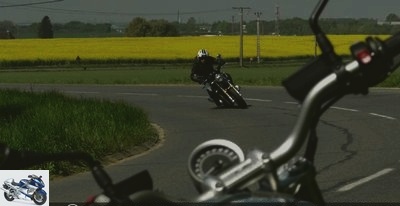
In addition to its superb sound, the Honda 4-cylinder boasts exquisite flexibility and a precise and smooth "clutch-box" assembly. Unsurprisingly with regard to its engine architecture, the R Nine T Pure is less at ease under 2000 rpm and above all rougher in selection despite commendable progress in this area: we are far from the rough and slamming transmissions of the old "flats" to grandpa " !
The injection is well calibrated on the two motorcycles, but the pulling of their accelerator is too long, forcing you to break your right wrist to put full throttle! Admittedly, this is not the desired goal, but a biker remains a biker: being a fan of classic motorcycles does not mean denying oneself the pleasure of putting the handle in the corner from time to time! "On the contrary," some will add, recalling that putting gas on this type of motorcycles of reasonable power is much less "permicidal" than with a Superbike of 200 hp. !
In short, in this retro segment as in many others, a beautiful engine well filled and generous in sensations will always be emulated. Unfortunately, if the Honda unit perfectly fulfills this first criterion of beauty with its elegant two-tone surface treatment, its placid temperament does not arouse the same enthusiasm. Its not very demonstrative revs, already pointed out by MNC on previous generations, even frankly struggle to convince.
BMW active, Honda "Pas Raceuse"
Its acceleration is without relief, except for a slight gain of pep between 6000 and 8000 rpm which settles quickly when approaching the switch at 9000 rpm. And the vibrations transmitted in the saddle and the handlebars indicate that high revs are not especially his thing. Worse still: this engine is not very torquey in terms of its displacement – 1140 cc, all the same! – with revivals a little lazy under 4000 rev / min. Its large gear does not help: the CB110 pulls very long, especially on higher gears.
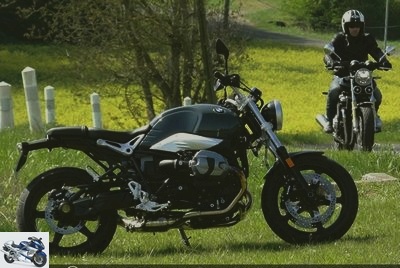
Faced with this voluntary mechanism but without great enthusiasm, the BMW opposes a formidable tone, capable of eclipsing its rival with one, or even two more reports (in 6th at low or mid-revs, the German starts in front of the Japanese in 4th )! The difference is spectacular between 2,500 and 5,000 rpm: the BMW leaps almost nervously, leaving a much less responsive Honda in place. The 20 hp and 25 Nm difference between the two motorcycles does not explain everything: the additional weight of the CB1100 RS (33 kg more than the BMW) and its timid character also play a role..
The expressive engine of the R nine T Pure, in tune with its strong sound, also has the advantage of little vibration, except in the revs (from 160 km / h in sixth). The downside of this sportier temperament: the BMW is not exempt from slipping on strong accelerations, reminding us that the "ASC" traction control option is not superfluous to channel its 110 hp. Likewise, the rear wheel can lock up during sudden downshifts on slippery surfaces, due to its fairly high engine braking..
There is no risk of this type of overflow on the CB1100 RS: its new anti-slipping clutch keeps a close eye on the downshift phases, while 91 hp – too much – well raised "mechanically" regulates possible slipping. Except in the wet or in gravel, spinning the rear wheel under acceleration is simply impossible! Too bad the Honda engine manufacturers did not give the "4-legged" a little muscle, especially on this "RS" version….

In contrast, the BMW offers a mechanic anything but shy, quick to take turns! The German’s thrust, as vigorous as it is sensational, knows no downtime: it hardly flexes as the switch approaches, including on the last gears thanks to its well-stepped gearbox. The turbulent retro "hangs" and 210 km / h in 5th without forcing, then in 6th exceeds the last graduation of the counter (220 km / h).
Subject to the same exercise, the Honda regulates to 185 km / h because it is electronically restricted like the previous model. The opportunity to note a reduction in its direction at very high speed not always reassuring, noticeable from 160 km / h. A phenomenon undoubtedly revealing the limits of its cycle part, in particular its classic double steel cradle chassis. The BMW Nine T Pure, it is never faulted in terms of stability (thank you for the steering damper ?!).
- MNC Smart-Video :
Verdict: to be or to appear? BMW has chosen !
Objectively, the victory of this new duel goes to the BWM R nine T Pure: with a selling price slightly lower than that of the Honda, the German is nevertheless superior in many areas, especially on a dynamic level. Efficient and expressive engine, sharp chassis, evocative look: the little sister of this "dear" R Nine T (15,700 € in standard version!) Is really successful and attracts the eye with its quality components.
However, the CB1100 RS does more than defend itself, in large part thanks to its superb line and the care taken in its design as well as classic details. Very desirable with its "Superbike" front end and its yellow "racing" combinations, the Honda embodies the retro spirit to perfection. The CB1100 is simply magnificent, when its rival – more massive and less polished – appears less graceful.
Or, ultimately, totally subjective criteria since some may say exactly the opposite! It is therefore impossible to grant the Honda victory on this sole basis of aesthetic accuracy. Moreover, if the drafting of MNC feels a real crush on the line of the CB1100, it also expresses a rant against its lack of motor character and its "stiff" shock absorbers, absolutely not in line with the sportiness suggested by its suffix "RS"…
Related articles
-
Duel BMW nine T Pure Vs Honda CB1100 RS: classic pleasures Beautiful, chic and very legitimate in the neo-retro motorcycle segment, the Honda CB1100 only…
-
Duel Honda CB650R Vs Yamaha MT-07: chic roadster against shock roadster Exceeding a reference requires either putting on the brakes or taking another…
-
Duel BMW R1250RT Vs Honda GoldWing: New deal in Moto GT The new BMW R1250RT has just been released! To evaluate this 2019 novelty and its variable-timing…
-
Duel BMW nine T Pure Vs Honda CB1100 RS: classic pleasures Beautiful, chic and very legitimate in the neo-retro motorcycle segment, the Honda CB1100 only…
-
All Duels – CB1100 Vs XJR1300: the classic is fantastic! – Back to the past…
CB1100 Vs XJR1300: the classic is fantastic ! One is a modern motorcycle designed ‘old-fashioned’, the other a roadster with fine remains that has become…
-
Duel Honda CB1000R 2018 Vs Triumph Speed Triple RS: chic duo for shock duel Two new maxiroadsters land in 2018: the CB1000R, eagerly awaited by Honda…
-
Duel BMW K1600GTL Vs Honda GoldWing 2018: Cruising Face Off… Forget Commander Stubing and his Love Boat . Rather, embark with Site for a cruise that is…
-
Duel BMW R nineT Vs Triumph Thruxton R: recreation (c) tives ! Some motorcycles do not need any artifice to seduce, their magic working at first glance ….
-
Duel F750 GS Vs Tracer 700: small trails, large road bikes ? New distinct look, improved practical aspects, two-cylinder 689 cc to Euro5 standards: the…
-
Duel Triumph Street Triple R Vs Yamaha MT-09 SP 2018: triple muse ! Will the new suspensions of the Yamaha MT-09 SP give it the rigor it needs to keep…